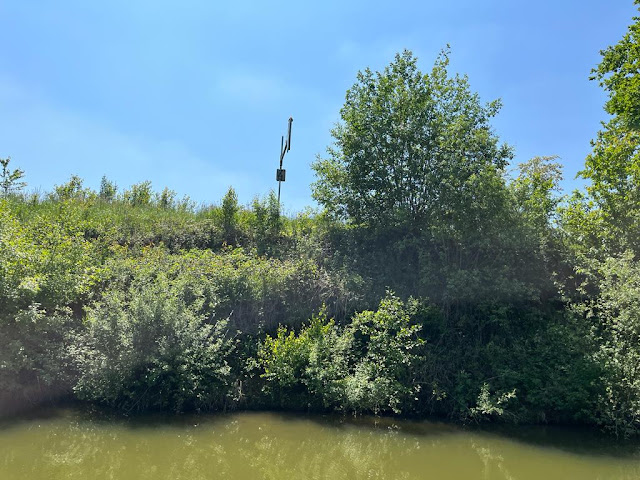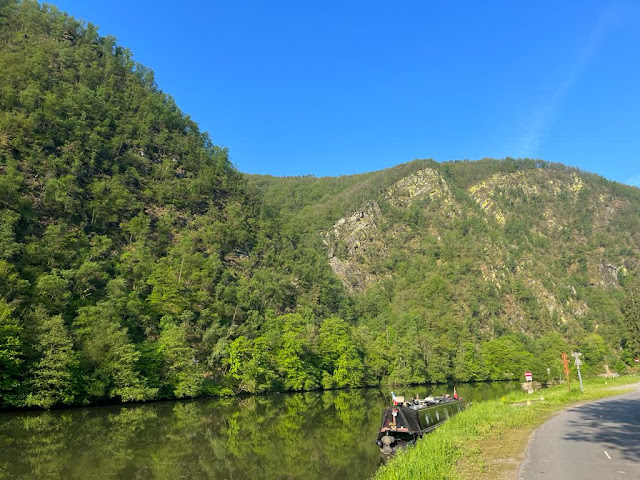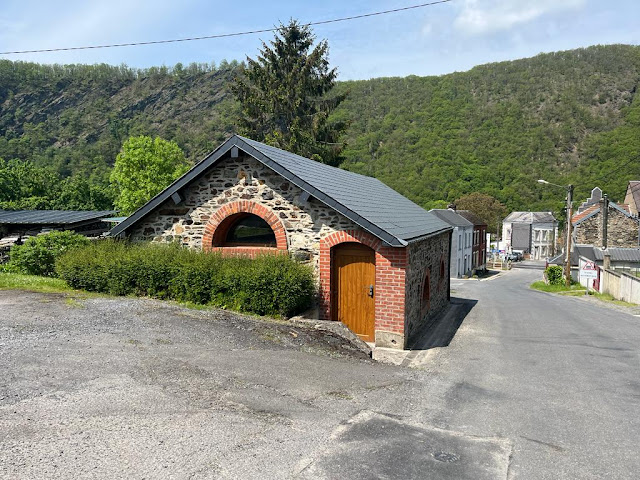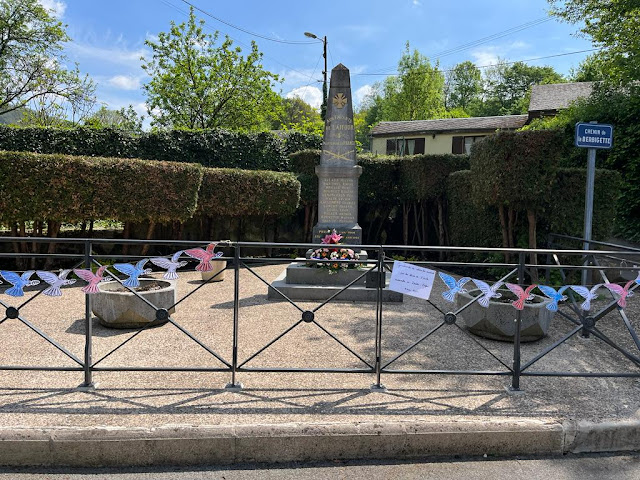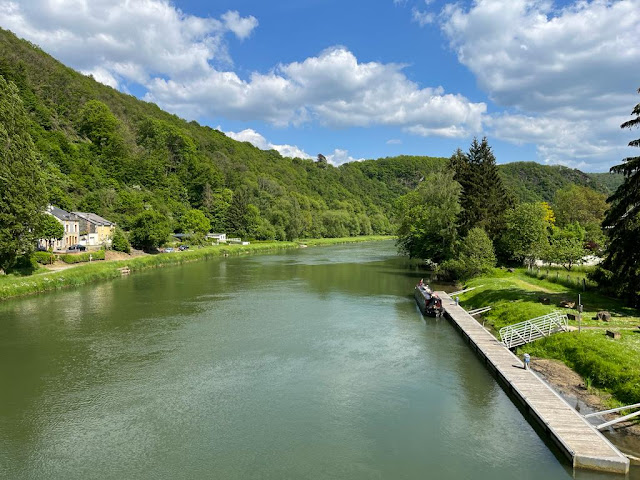SUNDAY 21 MAY
On Sunday morning we drove to Pont-à-Bar which is where we’ll be
leaving the river Meuse to join the canal des Ardennes. We left the car near the hire boat base two
locks up the canal and walked 11 kilometres back to the boat along the river. We saw lots of butterflies during our walk
including plenty of small heaths which is the first time we’ve seen them this
year, so it seemed they’d all emerged at once.
Other firsts for this year were a wall brown and a map. Maps are not found in the UK, but we often
see them over here, they are unusual in that the adults from the first and
second broods each year are quite different.
The summer brood adults are predominantly black with red and white
markings, whereas this was the far from fresh spring brood individual we saw:
 |
| Map butterfly near Port-à-Bar |
The plan for this week is to start our journey on the canal des Ardennes exploring the places and countryside on the way. We’ve really enjoyed being on the Meuse with its large meanders between high, forested hills and would highly recommend it as the whole journey has been stunning. Although the Meuse flows through mainly rural areas there are quite a few large towns, so we were never far from civilisation and commerce. It’ll be strange going onto the canal as it is very rural with only a couple of small towns and the occasional village so food shopping will have to be planned carefully.
MONDAY 22 MAY
The canal des Ardennes runs for 88 kilometres through 47 locks from the Meuse at
Pont-à-Bar to the canal latéral à l’Aisne at Vieux-lès-Asfeld, in effect
creating a link between the rivers Meuse and Aisne. A 12-kilometre-long
branch about halfway along used to lead down from the village of Semuy to the
town of Vouziers but is now closed to boats. The design of the canal started in 1793 with
work commencing in 1823 and was fully opened by 1831. The enlargements to the locks and channels to
the 38 metre Freycinet barge standard was carried out just 15 years later, in
1846.
 |
| Canal des Ardennes – we’re cruising from east to west |
The whole canal is only used by pleasure boats as nowadays there is no commercial traffic even though the locks are large enough to take the small standard péniches. There is a hire boat base at the Meuse end, where we've left the car, but apparently hirers invariably holiday on the Meuse rather than tackle all the locks and cope with a lack of towns on the canal. Hopefully, we will be travelling the length of the canal and then joining the canal latéral à l’Aisne before returning to the area around Reims which we have been through several times before but not from this direction. I say hopefully as we’d planned to travel on the canal in two previous years but were thwarted by a lack of water on each occasion.
Having stayed a couple of nights in Lumes we decided
Monday was the day to get onto the canal and set out late morning for the last
few kilometres and final lock on the Meuse.
 |
| Our mooring at Lumes |
After passing through the unfortunate sounding Flize we got ourselves into our last lock on the Meuse only to find the gates wouldn’t close behind us so tied up securely at the bottom of the lock and called VNF. Our experience on the Meuse has shown that they seem to take around 30 minutes to arrive so we took the opportunity to have lunch while we waited. On most canals and rivers, someone usually appears promptly, and we hardly ever wait for as much as 15 minutes let alone half an hour. No one had arrived by the time we’d had lunch so I climbed to the top to have a look around and could see a barge was waiting to come down. It turned out to be David and Becky on Wanderlust whom we’d met a couple of years ago on the river Saône. They’d also put in a call to VNF, but it was still an hour before an éclusier turned up in his van and got us through.
 |
| Wanderlust |
 |
| The reciprocal picture with a posing Buddy |
It wasn’t long before we were approaching the first lock on the canal des Ardennes that would take us off the river.
 |
| Getting ready to leave the river |
Coming out of the lock we passed a long line of boats, some were old péniches that were now permanent liveaboards and the rest were river cruisers on their home mooring. River cruiser owners must find it an ideal place to keep their boat as there is only one lock to go down before they have hundreds of kilometres of river cruising in front of them. The lock also means the moorings are high enough above the river to be safe when it floods. We moored just before the second lock alongside the car that we’d left there the previous day, intending to stay the night.
 |
| Moored at Pont-à-Bar |
In the middle of the afternoon, I drove to Saint-Aignan and left the car near the canal tunnel there. It was only a seven kilometre walk back along farm tracks and, apart from a guy in a lavoir, I didn’t see a soul until back in Pont-à-Bar and that happened to be Karen taking Buddy for his last walk of the day. The walk had taken me through some lovely countryside and also the village of Hannogne-St-Martin where I found two lavoirs. Unlike most of the previous ones we’ve seen in Ardennes, these two were both open, and the full basins were fed by running water. At the first was the guy I mentioned, who was filling plastic containers and I checked that he didn’t mind before taking some pictures.
I have no idea what he was filling the containers
for but offered to help him carry them as he left. He was very appreciative of the offer but as
he only lived over the road, he said he could manage.
That first lavoir was also unusual for the Ardennes
département in that it had an impluvium style roof for water collection as well
as the running water:
Walking back to the boat, Karen and I agreed that we didn’t fancy staying where we were moored by the lock in Pont-à-Bar and that we should move out into the country. We went up the lock and then through the hire boat base at the top. Opposite the hire boats was a boatyard that was reminiscent of some of those found in England with most of the boats in need of or even beyond love and attention. We moored up after a couple of kilometres in an open stretch near Hannogne-St-Martin where I’d seen the two lavoirs. Not only was it peaceful with far reaching views, but as there wasn’t a path on either side of the canal, we were free from passers-by so, apart from some inquisitive cows, had the place to ourselves.
.jpeg) |
| Evening at Hannogne-St-Martin |
On Monday we cruised 12 kilometres up three locks.
TUESDAY 23 MAY
 |
| Morning view from the other direction |
I’ve not mentioned the weather for a while as it’s now as expected for this time of year which means it’s well and truly shorts and tee shirts every day. Saying that, it was cloudy when we arose on Tuesday and didn’t clear until lunchtime but at least it was still warm. Over the last week or so the warm weather jobs have been done such as getting the mossie nets out to enable us to sleep with the doors open, cleaning the stove ready for the winter and finding the rear deck parasols and outside furniture.
Having found a pleasant mooring, we stayed put on Tuesday taking
in a couple of walks. We visited
Hannogne-St-Martin where I’d seen a couple of lavoirs when walking back to
Pont-à-Bar after dropping the car further up the canal. To our delight we found three further lavoirs
in the village, bringing the total to five which is amazing for such a small
place. The other pleasing thing was that
all the lavoirs were still in water and all bar one had impluvium style roofs.
 |
| Sandstone buildings around the church |
The predominant building material in the village was sandstone making a welcome change from the slate encountered along the Meuse.
 |
| Sandstone mairie |
Back at the boat we started talking about how we hadn’t heard the mating calls of frogs this spring. A little later we realised that we must have subconsciously heard them because the place suddenly seemed to be alive with them.
WEDNESDAY 24 MAY
While Karen had her morning run Buddy and I went for a walk and
ended up at the far side of Hannogne-St-Martin where we found yet another
lavoir, bringing the total in the village to six. That’s the most we’ve found in any one place
let alone in a village with a current population of just over 450. Over coffee later Karen and I discussed why there
were so many and had several theories.
If a village had just one large lavoir then any gossip would be known by
everyone in the village almost immediately.
The six lavoirs in Hannogne-St-Martin were all relatively small so each
would only serve a few houses. Assuming
each lavandière used the lavoir closest to her home then this gives weight to
our favourite theory that it prevented, or at least slowed down, gossipmongering by containing it to just
the few houses that used each lavoir.
By the time we left for Malmy, three boats had gone by and with
three or four boats passing us each day we’ve been on this canal it’s obviously
a lot busier than we thought it would be.
That’s good news really as it means the canal is being used. Having been on the river for a few weeks it
was a nice change to be on the tranquillity of a canal and it was amazing how
quickly the landscape had changed from the steep sided wooded and rocky valleys
of the Meuse to arable and livestock farming.
 |
| Leaving Hannogne-St-Martin for Malmy |
After three kilometres we went up the first of the two locks immediately before the Saint-Aignan tunnel where I’d left the car on Monday. Once we were in the second, the gates wouldn’t close fully behind us which meant the lock wouldn't start filling. We were a little surprised that we had to call VNF when we’d only be on the canal for a few days as Becky and David, who’d just cruised the length of it, told us they’d only had to call VNF twice.
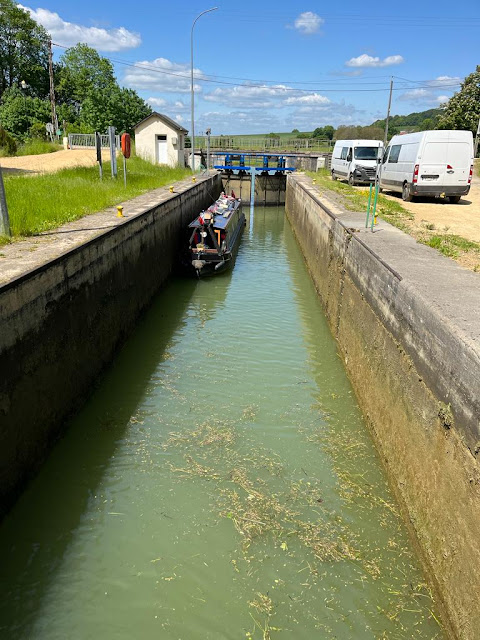 |
| The gates not completely closed |
 |
| Pretty lock cottage extended at least twice over the years |
Once the éclusier arrived we were soon at the top and Karen and Buddy got off to take the car to Malmy where they would leave it so they could walk back to meet me. Driving through Cannage the stonework behind a large ash tree caught her eye:
She stopped and went to have a look and sure enough, eagle eyed
Karen had found our first open air lavoir in Ardennes, albeit in need of some love:
I only passed one settlement on my journey; a village called
Omicourt which was a cluster of farm buildings and houses around a small church, typical of the villages we'll encounter along this canal.
 |
| Omicourt |
Karen and Buddy were waiting at the lock at Malmy when I arrived and having gone up the lock we tied up for the night using an old commercial bollard and pins.
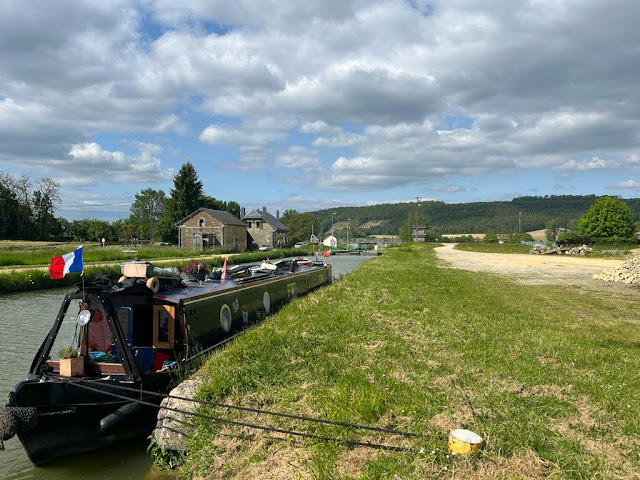 |
| Wednesday night mooring at Malmy |
On Wednesday we cruised nine kilometres, up three locks and through one tunnel.
THURSDAY 25 MAY
We left Malmy for La Cassine after breakfast on Thursday morning
under glorious blue skies. We’re finding
that we’re really enjoying this canal; it’s so clean and weed-free and, with its
deep sides we can just moor anywhere so there’s no worrying about whether or not
there’s space at official moorings.
 |
| Leaving Malmy on Thursday morning |
After four kilometres we stopped at a tiny place called Ambly consisting of just four dwellings where it looked ideal to spend the middle portion of the day:
It turned out to be a good spot to stop as we saw our first
mazarine and common blues of the year. Over the last few days I'd been thinking that we wouldn’t see any dingy skippers this year as it
was getting a bit late in their flight season but fortunately found one flying
in the same patch of birds foot trefoil as the common blues.
 |
| Top: Female mazarine blue. Bottom: Male common blue |
Before setting off again we walked back to Malmy to retrieve the car. Even though some of the walk was on a road it was very quiet, other than when tractors towing silage trailers came past. The numbers and sizes of the vehicles we saw led us to believe a team of contractors had been brought in by the local farmers for the silage harvest. Malmy was so small, a dozen or so houses, that it didn’t even have a mairie, but it did have a church standing someway outside, which we found was built in the 1200s.
 |
| Church standing quite separately to the village |
In the middle of the afternoon we moved the car down to the lock at La Cassine and looked for a convenient place to moor which turned out to be just below the lock. We walked back to get the boat and moved down to the mooring which by then was partly in some welcome shade.
 |
| Moored at La Cassine |
The South Ardennes cycle route is due to run along the length of the canal des Ardennes making it ideal for Karen’s runs. It’s not completely open the whole length yet as the section from the Meuse to Le Chesne (the bit we've cruised so far) is still under construction so Karen has been finding alternative routes. The construction seems to have reached La Cassine where we were moored as can be seen in the picture above. We took advantage of having the car to check if it was open the 11.5 kilometres to La Chesne; that would mean Karen could move the car there on Friday morning and run back.
It was worth the drive there as not only did we confirm the cycle
way was open for Karen, but we also passed through two villages both of which had
lavoirs. It certainly seems that we are
now finding plenty having had quite a dearth of them for the first few weeks
this year. While in the first village,
which was called Sauville, we had a walk around.
 |
| Sauville church and war memorial |
 |
| Sauville mairie |
We didn’t get out and have a wander around Tannay, the other village, other than to park to see the lavoir which were passing on this rather unfortunately named road:
On Thursday we cruised five kilometres through no locks.
FRIDAY 26 MAY
Karen went for her run early on Friday morning before it got too
warm combining it with moving the car to Le Chesne. She drove there first and then ran back along
the cycle path that wasn’t due to open until 8th June but was
practically finished and easy to get around the barriers. I took Buddy for his morning walk while she
was gone and didn’t see a soul other than a tractor driver tedding his hay. We did come across a slow worm sunning itself
though:
It's strange but Buddy, who loves chasing anything that moves from
squirrels to sheep, has never shown any interest in snakes or lizards. Once we were all back at the boat, we left to
cruise the 11.5 kilometres to Le Chesne where we planned to stay
overnight. We passed two moored boats on
the journey, our first in nearly 30 kilometres since passing the boatyard at the start of the canal:
We had two locks to ascend and then were on the summit where Le
Chesne sits, and we arrived there at midday. Le Chesne is the second largest town on the
canal but with no market or supermarkets, just one 7-11 store, a
bar and a couple of restaurants it’s not particularly large.
 |
| Arriving in Le Chesne |
There was a water point at the town mooring so the first things we did were to take on water and have lunch.
 |
| Town mooring |
Neither of us fancied staying in Le Chesne, much preferring to be out in the country so we decided to move on after lunch. Ahead of us was a chain of 27 locks which take between six and eight hours to get through. There clearly wasn’t time for us to do the whole flight before the locks close at 18.00 but it was possible to moor after 19 locks at a place called Neuville-Day. Generally, stopping in a lock flight is not allowed or indeed sensible as the pounds are short and liable to drain somewhat overnight but the pound in Neuville-Day is longer than the others and VNF are happy for boats to moor there.
As we had five hours before lock closing time we thought we could make Neuville-Day in time so went for it. Karen moved the car to where we would moor and walked back up to meet me as I was coming down the flight. In case you're wondering why we're keeping the car with us this year it's because Joanna, one of our daughters, is visiting us at the beginning of June and we'll need it to be able to do some sightseeing with her.
Once the flight has been triggered the next lock in the sequence sets itself while the previous lock is being negotiated. It did mean that we would break the chain by stopping at Neuville-Day so would have to let VNF know and also when we would want the chain restarted. I nearly missed the receiver to start the chain as it was high up the bank and hidden by tree growth:
Nearly every lock on the flight has a lock cottage but apart from
a couple they’re uninhabited which is a great shame as they are built in
sandstone and are really pretty:
Most also still have their original lock information plates:
All went well until I came out of the fourth lock and two red
lights, indicating out of service, were on at the fifth lock, so I called
VNF. I also rang Karen to let her know
so she should also report it if she saw an éclusier on her walk up the flight. After a while a man appeared at the top of
the lock ladder, and I realised there was a boat at the bottom of the lock. He walked up to see me and it turned out that
he’d also called VNF. Fortunately, he
was French so was able to have a proper conversation with the command centre,
but it still took an hour for someone to arrive.
The éclusier arrived in an orange VNF van which was the first time
we’ve seen a VNF one that colour so we should have guessed things weren’t going
to go well. We have seen orange vans
before but that was on the canal de la Somme which is run by the Somme
département not VNF. The guy was
obviously a trainee as after getting the other boat up and out of the lock, he
shut the gates on us as we were about to go in. When we finally got his attention, he opened
them again and let us in. What any
normal éclusier would have done next is reset the chain for the Frenchman going
up and us going down. He clearly didn’t
understand about chains as he just didn’t know what to do. He saw us down the next three locks manually
with us getting more and more frustrated with him. In the end he went to his van, retrieved a
notebook and pen and made a phone call to the command centre They explained
what to do to reset the chain while he wrote down the instructions in his
notepad. At the fourth attempt he got
it right and with loud cheers from us the chain was reset so we could carry on without him.
 |
| Trainee’s van |
It was Karen’s joke that she couldn’t understand why a trainee was sent out on his own let alone one beyond retirement age. The communication with him was practically impossible as he always insisted on talking to us when we were at the bottom of a lock, and he was standing at the top. It can be quite difficult to hear someone above the echoes of the engine in a lock chamber but with the sound of water rushing over the gates behind us and the language barrier it became impossible.
We thought we’d explained to him that we would be mooring up at Neuville-Day after lock 19 but clearly hadn’t as he turned up when we were in number 17 and indicated it was gone 18.00 so we couldn’t go any further. We tried pleading with him but to no avail and he turned lock 18’s lights off. There was nothing for it but to tie up in the pound which is heavily frowned up for reasons I explained earlier. As it turned out it was another of those moorings where there were no passers-by and no houses in sight, so we had a lovely and peaceful evening.
.jpeg) |
| Friday night above lock 18 |
On Friday we cruised 18 kilometres up two and down 17 locks.
SATURDAY 27 MAY
Although we’d had a peaceful evening, the lock we were moored by
had very leaky gates and the sound of the water crashing into the empty chamber
did keep us awake from early in the morning.
We don’t usually mind the sound of running water and, like listening to
birds or frogs, find it soothing but it was just too loud once we were
awake. It didn’t help as we sleep at the
front of the boat which was right next to the lock gates. On top of that we
leave the doors wide open in the bedroom so there was nothing to block out the
sound.
We thought we’d get down the two locks that we were prevented from
doing on Friday and then moor for the day at Neuville-Day. First, we had to call VNF to get the chain
started and expected an hour’s wait until an éclusier turned up. To our surprise they were able to set the
chain remotely and we were soon off and down the two locks wondering why on
earth that wasn’t done the previous day to save the poor trainee from
floundering around. We moored up just
before the third lock and were just about to let VNF know we’d broken the chain
when an éclusier arrived at the lock in his van, so I was able to explain that
we were staying for the day.
 |
| Our mooring above the lock at Neuville-Day |
Lac de Bairon is a large reservoir that sits at the summit and provides the water for the canal des Ardennes and our target for the day was to walk around it. We had a lovely walk and when passing the waterside campsite thought it would make a beautiful place to stay.
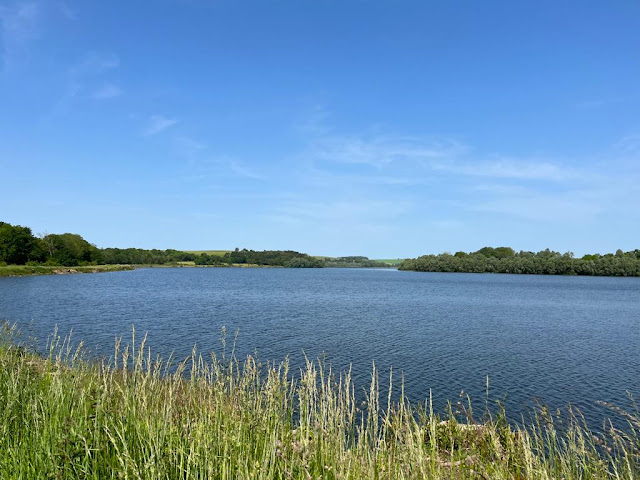 |
| Three quarters of lac de Bairon |
There was even a beach, but it seemed to be too early for any of the purported 40,000 swimmers a year to be swimming as people were only just arriving in their cars and setting up their barbecues.
We took the opportunity to wild paddle though:
We found a lavoir in the village on our way back and by the sides
of the basin implements used by lavandières were on display such as their wooden
kneelers, buckets and clothes barrows.
It was such a lovely day that we spent the rest of it outside moving between the sun and shade.
 |
| No, Karen isn’t ignoring me |
At one point Karen was carrying some plates and cutlery back into the boat and I restrained myself from calling out for her to be careful when I heard her swear. A knife slipped into the water and to make it worse a second quickly followed it. I got out our trusty magnet and soon retrieved one of the knives but not so the other. I was getting hot and bothered so left it for later in the day and when I had another go I lost my grip on the cable attached to the magnet and down it went too. So then I had to find something metallic and dense to tie to the end of a line that I could use to retrieve the magnet. Again, it took a couple of sessions but I got it back in the end.
On Saturday we cruised less than a kilometre down two locks.



.jpeg)




